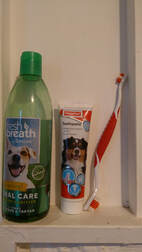 Dental care is for everyone. This week is about dental care for dogs and cats, as dental health for rabbits and rodents is a different bale of hay all together. If we’re being honest, there aren’t many of us who are on the ball and in the know when it comes to our pet’s dental health. When it comes to dogs, many owners feel that they can just give them a ‘specially designed’ dental chew every day and they all good, right? Well, maybe not. Good oral hygiene is an important and often overlooked part of your pet’s overall health and wellbeing, whether they’re a little nipper, golden oldie, cross breed or top-notch pedigree. Think about the last time you had a tooth ache, I try not to myself, but my point is you were probably miserable. Luckily for you, you are a human with thumbs and the ability to decide to take some painkillers or tell people to watch out because you’re not in a bad mood, you’re in pain; and you have reluctantly booked into the dentist this afternoon. Now imagine you’re a cat or dog suffering the pain of a tooth ache or sore gums. This not only has health and welfare implications but can also lead to serious behaviour problems. A good example of this is a condition in cats (particularly noted in Burmese cats) called ‘Feline orofacial pain syndrome’ quite the mouthful I know; but this is where dental problems are causing the cat so much pain that they paw at their own faces over and over and over again, until it is so raw that it often bleeds! There are some other signs that your pet could be suffering for dental discomfort such as:
For an older cat or dog, it can be stressful for both you and your pet to take a look at what’s going on. I know the only way my cat would let me see her teeth was if she was going to plant them in my hands during play time! But there are some early warning signs to watch out for:
Even the saying ‘getting long in the tooth’; this apparent growing of upper canine in old pets is caused by periodontal infection forcing the tooth out of it socket. A dental infection can also have affects on other body systems, if there is a high bacteria level or if the pet is immune compromised or suffering from another illness. So as any dentist will tell you, prevention is better than cure and maintaining regular oral hygiene routines will help keep those tails wagging.  Here are the things that I do for my dog’s Dental health:
There is a product that I’m going to start using next week- Beaphur tooth gel. This product is suitable for cats and dogs, and cleans teeth without the use of a brush. The gel contains enzymes that fight the bacteria that cause bad breath and breaks down plaque. Any plaque that’s not brushed away would combine with calcium to form tartar, but this gel has ingredients that bind to calcium, to prevent further formation of tartar. This product can be used 2-3 times a week, so I’m hoping that it will be an easy addition to the pet’s routine. I’ll let you all know how it goes! A special thank you to Beaphar Uk training for the graphic and teeth pictures
0 Comments
Leave a Reply. |
AuthorRebecca, owner and founder of R and R Pet services. Archives
May 2022
Categories |
Thank you for visiting!
Copyright © 2016
 RSS Feed
RSS Feed